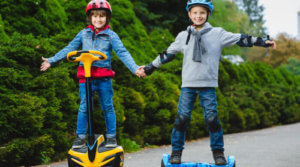The first day at kindergarten is a challenge for every child. For the first time, they are separated from their parents and have to fit in with a larger group of kids of roughly the same age. Admittedly, the demands of a school class do not yet prevail here. Nevertheless, it is inevitable that the kids will repeatedly reach their own limits.
But many things can also change at home when the kids reach kindergarten age. They need a lot of attention and make new demands on their parents.
This article is devoted to problem situations of families with children aged three to six.
Also interesting:- The 11 best kindergarten backpacks
- The 8 best Crocs for children
- The 18 best balance boards for children
Table of contents
When Parents Discuss
Especially with toddlers or kids of kindergarten age, it is difficult to talk on the phone or hold conversations in peace. It seems like you have to hide in the basement to discuss in peace and without interruption.
Children interrupt us adults because they want to attract our attention. In doing so, they are more or less successful: at least they get attention in the form of scolding.
If children have the feeling in everyday life that they are not getting enough positive attention (playing together, talking about everyday life in kindergarten, etc.), they provoke negative reactions. For example, by interrupting their parents in conversation.
And this is also where the solution to the problem lies. In an interview for the online edition of the Süddeutsche, Trudi Kühn advises long-suffering parents the following:
-
Involve the children in everyday life again and again.
-
Spend enough time with the kids every day.
-
Establish clear rules in advance for the situation “Mom or Dad is having a conversation”.
-
Explain that adults also show respect for each other by not interrupting each other.
Thus, in the child disappears the need to make themselves known in a negative way. The last item in the above list applies especially to older children. Understanding respectful interaction helps to improve the kids’ sensitivity in this matter.
If these measures don’t help, Ms. Kühn says you can also react as follows.
If you are interrupted by the child, put your hand on his or her shoulder and continue the conversation without communicating further with the child (not even nonverbally!). In this way, you show the child that you are paying attention to him or her. This form of attention is enough for many kids.
Younger kids in particular want to sit on your lap and listen. Depending on the nature of the conversation, this is a way to continue talking relatively undisturbed. If it becomes too restless, it should be given a choice.
-
It may stay in the room if it stays quiet.
-
Or it can play in another room if it finds it difficult to sit quietly.
It is difficult if you are already angry or irritated because the child does not want to be quiet. In this situation, it is better not to say anything, because respectful interaction with the child is then hardly possible. It helps to first calm yourself down and take a deep breath. Then you can turn to the child and explain why you are in such a rage. In doing so, you should always express your own feelings.
Babysitting By Older Siblings – a good idea?
As soon as the children get older, many parents breathe a sigh of relief. Because now the older kids can take care and you don’t have to constantly look for a babysitter. Whether a younger child can be supervised by his or her sibling depends on several factors. Basically, the babysitter should be at least twelve years old to watch another child of kindergarten age.
-
However, that alone is not enough. The older child must be able to cope if the sibling cries, is petulant or even cries.
-
If the age difference is too small, the younger child may not want to defer to his or her sibling.
-
In the beginning, leave the kids alone during the day and only for a short time. The duration of the absence can be extended over time.
-
Parents should check in with the kids in between. In addition, you should always leave a phone number for the kids in case of an emergency. If your cell phone breaks down or you can’t be reached for other reasons, the kids should be able to call a neighbor or other family members.
Pets: At What Age Can Children Take Responsibility?
In principle, kids can take responsibility for a pet from about age 5.
However, you shouldn’t make this decision solely based on the age of the child. The decisive factor is also whether you want to have a pet at home and can live with the disadvantages associated with it.
If the decision has been made, it is best to inform yourself together with the children about:
-
Types of animals that come into question.
-
Housing conditions (cage, free running,…).
-
Acquisition and running costs.
-
Necessary vaccinations or other treatments.
-
Susceptibility to special diseases.
-
Daily time expenditure.
-
Special needs and species-appropriate husbandry.
-
Which breed (e.g. dog) is particularly easy to care for and fond of children?
Children usually have great fun acquiring special knowledge about the desired pet species. In addition, it gets a clearer picture of the needs of the animal and the associated effort for the child itself.
Also deal with the question of whether the animal can be left alone with the child. Exchanging opinions with experienced pet owners or breeders will help here.
Animals like rabbits or kittens invite to pet them extensively. This is fine in itself. However, the child should definitely learn to accept the animal’s limits. In this regard, it is better to acquire a full-grown cat, which can better define these boundaries and express itself. Especially in the case of smaller children, one should consider acquiring only adult animals, as they can better defend themselves in the event of excessive “love” on the part of the child.
Tip: The animal should “belong” to all family members. Otherwise, there may be rivalries between siblings, which are carried out through the pets.
Topic dog: Despite typical breed behavior, the dog should be visited in advance. The child should be given the opportunity to pet the dog and play with it. Here it shows quite quickly whether the two will get along or not. Especially older animals from the shelter can meet children with suspicion and hostility if they have had bad experiences in the past.
The Others May Also!
In the kindergarten age, at the latest however after entrance into the elementary school, Kids compare the own family with those of other Kids. Then they may complain, “Paul has a TV in his room. Why can’t I have one?”. Parents are challenged here to enforce their parenting decisions – even if friendly families do it differently.
Try to convey to your child that you want the best for him or her and explain why you are denying him or her something specific. Only when the child understands your motives can he or she – perhaps – accept them. If not, you can meet in the middle – in the spirit of democratic education – and find a compromise. If possible, consider in advance where your limits are and what you can assure the child without a guilty conscience.
By the way, through situations like this, the child learns to take other people’s opinions into account and to compromise. It also feels valued when it is not simply ignored. They want to understand why things are different at home than elsewhere. Then they will be ready to take a step toward you.
Bedtime Story
All kids have a favorite story that they would love to have read to them over and over again. This can get pretty boring and exhausting for adults.
But you can’t blame the little ones, because.
-
Kids discover new aspects with each repetition.
-
They often only understand the story as a whole when it has been read several times.
At this point, I urge you to close your eyes and get through it! It gives children a lot of pleasure and strengthens the parent-child relationship if we do them the favor of accompanying them with their favorite story until they fall asleep.
When Children Whine In The Car
Kindergarten kids have a great urge to move. It is therefore virtually impossible to break them of the habit of whining in the car. However, the following measures can help to make the car ride more pleasant for everyone involved.
-
Take regular breaks.
-
Use playgrounds at rest stops.
-
Provide distraction during the drive (picture books, radio plays,…).
Tip: Special storage bags are available at automotive stores that can be attached to the back of the car seat. Fill them with painting utensils and toys so that your children don’t get bored during the drive. Scratch pictures, coloring boards as well as other exciting creative toys provide the right distraction and go down well with all kids.
Also, keep in mind that kids are especially quiet when you keep them busy with new toys. Before a long road trip, it can be helpful to pick up some great items at the specialty toy store. Don’t hand out these toys until just before you start the car ride!
Older kids will enjoy new comic books and books.
If you have time in between, you could have a picnic. This way, growling stomachs don’t lead to bad moods and everyone has the opportunity to go to the bathroom briefly. In addition, a picnic in the fresh air is fun and a great change from sitting still in the car.
Make sure you know in advance if there are any sights along the route that might be interesting for kids. Put in a few exciting stops along the way, and the travel day will be more bearable for kids.
Even if no activities are planned in between, you should always leave as early as possible with children. Only in this way is it possible to take breaks again and again without arriving too late at your destination. Also keep in mind that you always have to expect delays when traveling with children.
Siblings can play cards with each other. This also distracts them for a while.
Tip: Use stopovers to let the children change seats afterwards. If you don’t always sit in the same place in the car, boredom is less likely to set in.
Quarrels With The Sweet Tooth
If something is forbidden, it exerts a special attraction on kids. Many parents get frustrated because their offspring keep going to the snack drawer without asking permission.
Here, it can help to use a trick of the laissez-faire parenting style. Simply grant your kids free access to the snack drawer. Let them take as much and as much as they want.
In the beginning, this can lead to kids having no appetite at lunchtime or suffering from stomach aches. In the long run, this becomes too unpleasant even for the most hardened sweet tooth, so that snacking usually levels off by itself. This approach can only work if the snack drawer is regularly filled with a manageable supply. It is not acceptable to buy more and more sweets and let the kids go on a “sugar trip”.
Ideally, you should coordinate with grandparents and teachers so that Mom’s or Dad’s candy drawer acts as the sole source of candy for the kids
What To Do With Left-Handers?
Children approaching school entry age develop a pronounced “sidedness.” This means that one half of the body is favored. Intuitively, the child concentrates on this side when playing, doing handicrafts or helping with gardening. In this way, the child becomes right- or left-handed.
Incidentally, this sidedness is a basic prerequisite for many learning processes at school, such as learning to write. About 20 years ago, it was common practice to re-educate left-handers to become right-handers. They were forced to write with the “nice” hand.
Today we know: This is not a good idea. If you influence the sidedness of the child, it can be enormously impaired in its learning process. Suddenly, the child finds everything difficult and is confused.
Meanwhile, there is no reason to retrain the child anyway. There are now left-handed versions of almost all everyday tools. Even many musical instruments are available in both left- and right-handed versions.
Morning Stress
Kids like to dawdle after getting up. Kindergarten children have to learn early enough that there are certain routine activities that have to be done in the morning. If you train them before they start school, you save yourself unnecessary stress during the much more stressful school days.
Of course, routines like putting on a jacket or brushing teeth can be combined with a fun game or story to get the child’s attention. However, this game needs to have boundaries so that it doesn’t break the time frame.
Here are a number of tips for stress-free mornings:
-
Prepare snacks and breakfast the night before and refrigerate .
-
Lay out clothes for the next day the day before.
-
Make a plan for the morning: Whoever has to get out first gets to go to the bathroom first.
-
Allow enough time for the morning routine: don’t let the kids snooze too long, or the remaining time might be too short. Still, make time for morning cuddles – it improves their mood.
-
Wake up gently: Radio alarm clocks or pleasant wake-up sounds instead of nerve-wracking beeping make for a pleasant start to the day.
-
Provide a sense of time: Use nursery rhymes to help kids understand the proper time to brush their teeth (about 3 minutes). There are also special children’s songs for getting dressed and eating breakfast. If you run a (pleasant) corresponding children’s CD in the morning, the children will know by themselves over time what they still have to do. This way, it is not necessary to be constantly breathing down their necks.
-
Appreciation and love: This tip helps especially on days that are particularly challenging. In the case of the kindergarten child, this could be the first day with a new teacher. In this case, it helps to emphasize the positive aspects of the day in the morning, for example by talking about the planned afternoon excursion or the child’s upcoming birthday at the breakfast table. This way, he or she can look forward to something positive during the day, despite unpleasant circumstances.
-
Saying goodbye: a ritual. You can also say goodbye to each other with a round of cuddles, for example. In any case, the goodbye should be associated with something positive, so that it is easier for the children.
My Child Wants To Be Carried All The Time
Kids of kindergarten age can usually already walk safely and have become quite independent in this respect.
Sometimes, however, kids don’t want to walk, even though they could. Then they constantly whine that you should pick them up and carry them. Behind this is primarily a certain comfort. The child remembers being carried by you in the past and continues to try to enjoy that comfort.
Of course, if a child has actually become tired from walking, there is nothing wrong with picking him up. Otherwise, you can help yourself with distractions that motivate the child to move all by itself and like the “grown-ups”. Doll carriages or ladder carriages help to make independent walking appealing to the child.
Sitting Still Is Difficult
Kids of kindergarten age usually have trouble sitting still for long periods of time. This is fine and should not be demanded of them. It is not until they enter elementary school that they need to be able to concentrate without constant frolicking. If your child has a particularly strong urge to move, you should consider sending him or her to a preschool class. There, the focus is on topics such as concentration, attention, and even sitting still.
In the private sphere, forbearance and consideration are required. You should not expect kindergarteners to sit still during a long visit to a restaurant. It is true that they appreciate delicious food just as much as we adults do. Before and after the meal, however, going to a restaurant with adults is downright torture for younger kids.
If in doubt, it’s a good idea to visit only restaurants with play areas or corners, so kids can be themselves.
Fidgeting At The Dinner Table
Teaching a child table manners takes a lot of time. Despite everything, eating should be a communal experience that can be enjoyed. If you have to constantly admonish the children, however, this is not easy.
On the one hand, you should not restrict children with educational measures. On the other hand, it is in the children’s interest to learn social customs and to be able to behave appropriately to the situation.
The problem is that the table is often only about the kids’ missteps. There is usually no praise when kids eat without spilling or fidgeting.
Parents should lead the way as good role models. Admonitions are of little use if the parents themselves are sitting at the table smacking their lips. At this point, we would like to share the following tips with you:
-
Explain to children that others may not enjoy eating with them if they behave this way.
-
Establish rules of behavior together for eating at the table.
-
Children can forget rules from time to time. Don’t overreact and avoid stress at the table.
-
Don’t always take everything deadly seriously.
-
Learn and practice etiquette rules with small games.
Example for the last point: We play “Eat like fine people”. With noble table settings and appropriate table manners. Another time, we eat completely without cutlery and table manners to show the difference. Of course, the latter only works with kids who respect boundaries and can follow their parents’ rules. They have to understand that the parents dictate when to play and when not to.
In everyday life, it’s easier to resort to small mind games and thinking aids. For example, you could encourage children to imagine that there is a little cat sitting on their lap that needs to be protected. Leaning on the edge of the table squashes the little cat. On the other hand, behind the child sits a little mouse on the edge of the chair that must not be nudged down. Stuffed animals help to practice a straight sitting posture in this way.
Playground Instead Of Screen
Most kids have already come into contact with game consoles or PCs by the age of four or five. Depending on the child’s personality, the virtual world can have an insane appeal. Kids who used to love to move around can become real couch potatoes.
If a child spends several hours a day in front of a screen, their body and psyche can suffer over time. The child gets too little exercise, the circulation is weakened. The sensory stimulation that is so important for learning is missing out.
That’s why parents should limit their children’s time on PCs and consoles. Kindergarten children should rather play outside than sit at the PC. Elementary school children are best allowed a daily maximum of one hour on the PC.
PC-free days provide an opportunity to do something outside and not lose sight of the real world. In this way, teach your child that it is possible to romp outside even in “bad” weather. A rainy day doesn’t have to mean sitting in front of the PC all afternoon. A pair of colorful rubber boots, a good rain jacket, and warm clothes will ensure fun in the rain, wind, and weather.
New Love, New Life – Childish Jealousy
From later kindergarten age until after puberty, children suffer particularly badly from a change of partner. Therefore, you have to give them a lot of time to accept the new partner. Whether and when the child sees him or her as a parent varies greatly.
In the beginning, it is easier for the child if you hold back intimacies like kissing in front of him or her. It is also important for the new partner to make an effort to gain the child’s trust. However, only as far as the child allows it.
If it doesn’t want to work at all, then it’s a case of letting it go. A little distance and the chance to emotionally process the changes can work wonders. At the same time, the child should always be made to feel that he or she is still just as important to his or her mother or father as before.
Help, My Child Is Clumsy!
Kindergarten girls and boys differ greatly in their abilities. Not every child can handle kindergarten crafts right away.
However, a lack of fine motor skills can be easily compensated for. If you involve the child in the household, he or she will get plenty of opportunity to do so. So don’t be afraid to let the child – under supervision – do the dishes, dry off and cut fruit. This improves fine motor skills, and little fingers become more dexterous.
Visit To The Marital Bed
Kindergarten kids usually have very vivid dreams. If they have encountered many new situations during the day, these often manifest themselves as scary nightmares during nighttime sleep. This is how the events of the day are processed.
When the child wakes up and snuggles into bed with his parents, he feels so comfortable at first that he doesn’t want to go back to the nursery.
Nevertheless, you should bring the child back to its bed. Don’t leave it there alone, but cuddle with it a little, tell it a story or chat a little. Most kids will then get tired again very quickly and fall asleep calmly. In this way, kids learn to feel comfortable in their own room despite a nightmare.
Of course, you should also allow your child to wake you up in the future if he or she is afraid.
A promise is a promise…
Kids promise a lot when the day is long. A little later, it’s hard to stick to them. Parents are then justifiably disappointed in their children.
Younger kids are sometimes overwhelmed by keeping promises. If the promise is a long-term one, it is even more difficult. It is therefore advisable to give the child a manageable framework for the promise. Long periods of time should be avoided. For example, instead of saying, “Every week, clean out the rabbit hutch,” you should agree with the child that he or she will clean out the hutch by the weekend. Next time, simply remind the child again. In time, he will remember his chores.
If the child does manage to keep his promise, he deserves plenty of praise.
Practice makes perfect! Or is it?
Kids should discover their talents as early as possible and learn to use them. That’s why many parents try to get their children interested in learning an instrument or other activities before they reach school age.
What is well-intentioned can cause massive stress for the child. Basically, kids are not ready to practice regularly until they are about six years old. The fine motor skills necessary to learn an instrument also don’t set in until this age.
However, because starting school is a critical, exciting and at the same time challenging phase of life, additional stress should be avoided during this time.
Early music education is an option if the child expresses a desire to participate. It is geared to the children’s enjoyment and is more in line with their needs than conventional music lessons with a private teacher.
The Doll Has To Come Along!
Especially in the early days, it frightens small children to be separated from their parents in the morning. A stuffed animal they know from home can help. That’s why children like to take stuffed animals and toys like dolls to kindergarten.
This will come with time. Once the child has made friends at kindergarten and gotten used to his or her new environment, the doll and teddy can stay home again.
Problem: Refusal
Refusers do not only exist in school, but also in kindergarten. It is usually the case that kids are reluctant to leave their familiar surroundings to go to kindergarten at the beginning. Sometimes it’s the other way around. Kids who seem comfortable there at the beginning suddenly don’t want to go to kindergarten.
There can be many different reasons for this. In any case, it is important to approach these reasons. An open discussion with a lot of tact helps.
Sometimes the fascination initially outweighs the pain of separation. After a few weeks, however, the excitement is over and the child has increased problems with being separated from his or her parents. Taking the child out of the group is not a solution. Instead, say goodbye to the child in the morning with extra attention. An extra round of cuddling works wonders and calms.
In other cases, the refusal is not due to the morning goodbye. Then it may be that the child is afraid of certain situations in kindergarten. Try to find out if there was an altercation with peers. What happened and how did it come about? Many children are already helped by the feeling that they are not alone in their own fear. However, if an incident actually occurred, it can usually be settled in a meeting with the child’s parents outside the kindergarten. As a parent, however, you have to be very careful not to make the situation worse for the child.










